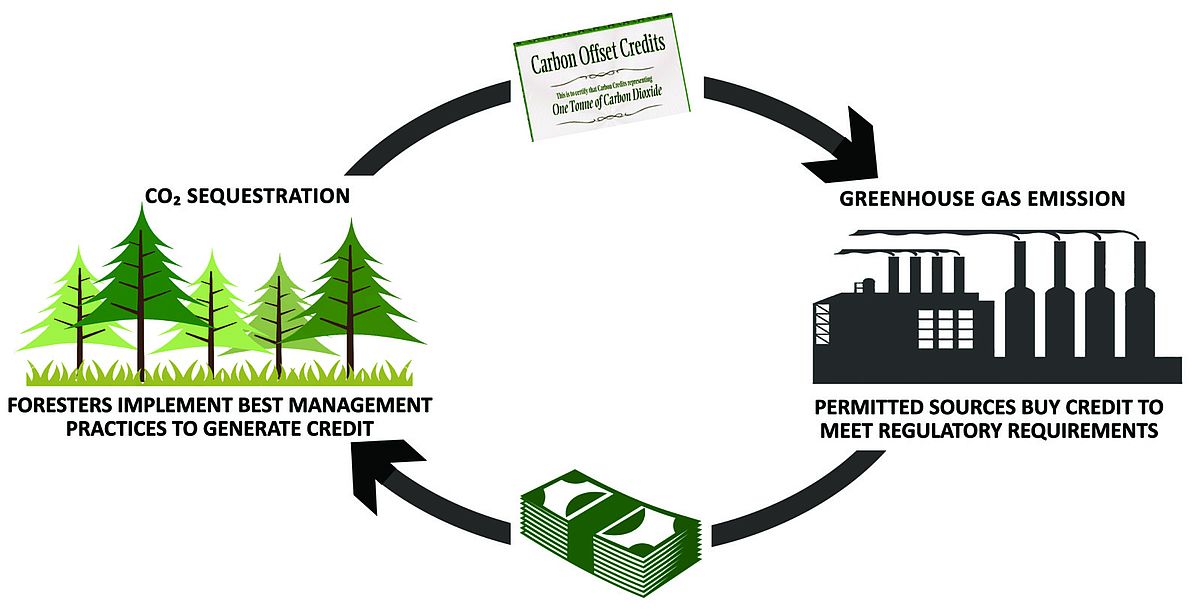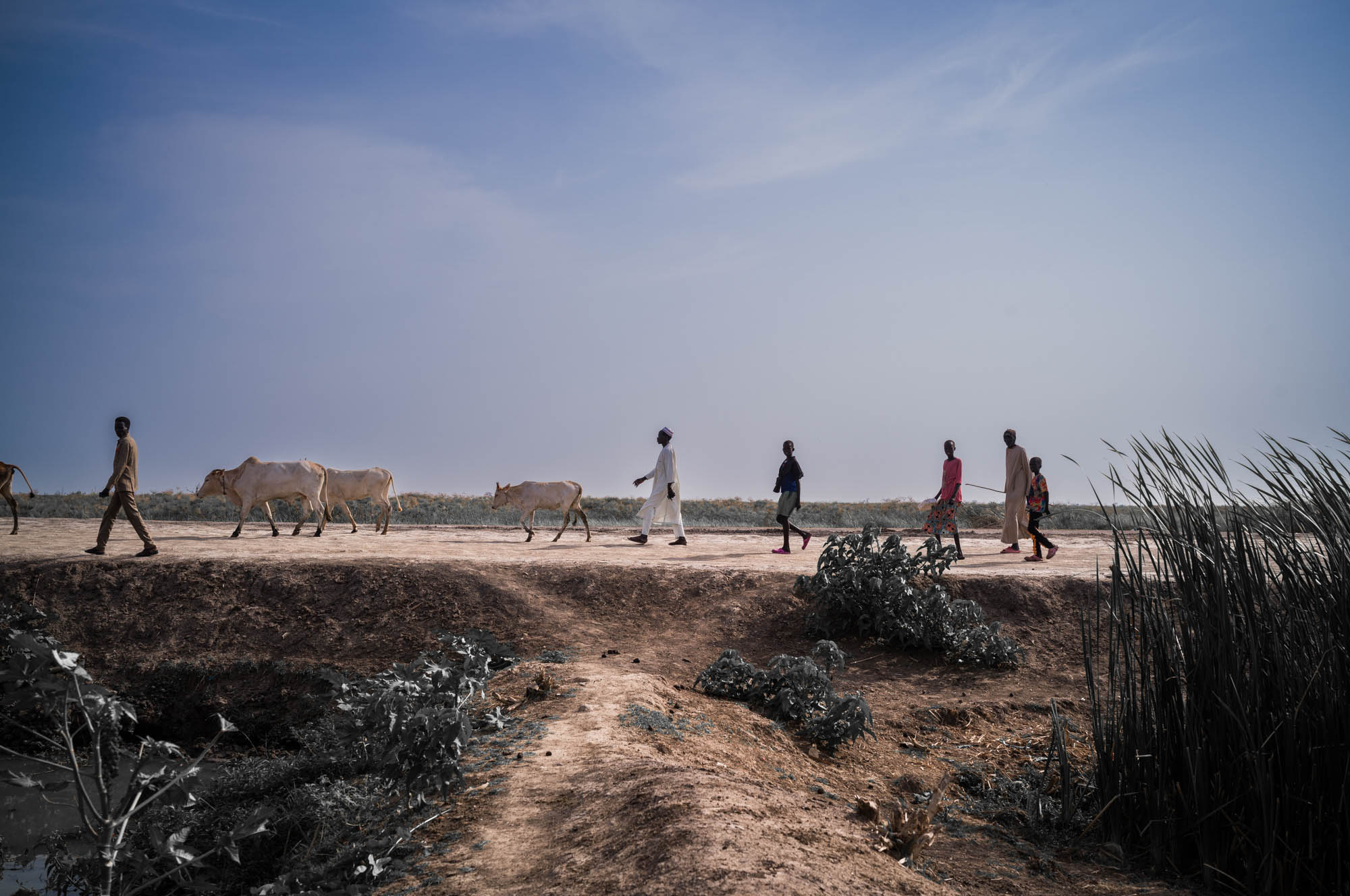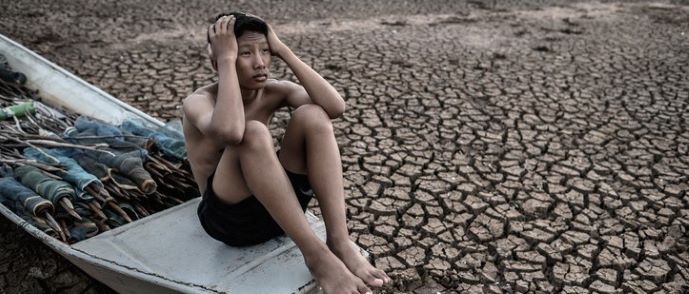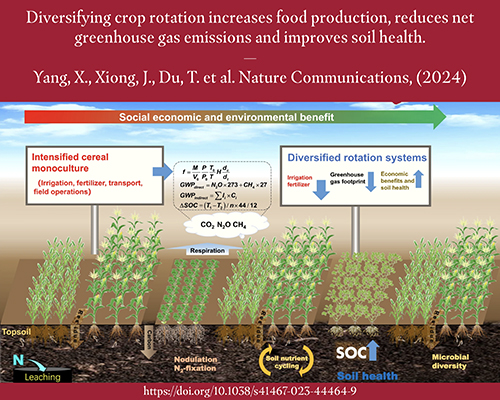Report on Rice-Crayfish Farming and its Contribution to Sustainable Development Goals
This report analyzes the environmental effects of integrated rice-crayfish farming, reframing the findings of a systematic study through the lens of the United Nations Sustainable Development Goals (SDGs). The research evaluates rice-crayfish farming as a green, low-carbon alternative to traditional rice monoculture, with significant implications for achieving global targets on climate action, food security, and ecosystem health. The analysis is based on field experiments, carbon footprint assessments, and DeNitrification-DeComposition (DNDC) model simulations.
Executive Summary: Aligning Agriculture with Global Sustainability
The study provides compelling evidence that rice-crayfish farming is a sustainable agricultural practice that directly supports several SDGs. Compared to rice monoculture, this integrated system demonstrates superior performance in environmental stewardship and resource efficiency. Key findings highlight its potential to advance global sustainability targets.
- Climate Action (SDG 13): The system significantly reduces net greenhouse gas emissions by lowering annual methane (CH4) and nitrous oxide (N2O) emissions, resulting in a decreased Global Warming Potential (GWP).
- Life on Land (SDG 15): The practice enhances soil health by increasing soil organic carbon (SOC) storage, improving soil structure, and promoting the formation of stable soil aggregates.
- Zero Hunger (SDG 2): By diversifying farm output to include both a staple grain (rice) and a protein source (crayfish), the system contributes to food security, improves nutrition, and increases economic returns for farmers.
- Responsible Consumption and Production (SDG 12): Rice-crayfish farming demonstrates a lower carbon footprint per unit of economic profit, representing a more efficient and sustainable production model.
Climate Action and Responsible Production (SDG 13 & SDG 12)
A primary contribution of rice-crayfish farming is its role in climate change mitigation. The system’s design and biological interactions create an environment less conducive to the production of potent greenhouse gases, a key target of SDG 13.
Greenhouse Gas Emission Reduction
The integrated system demonstrates a significant capacity to reduce GHG emissions from paddy fields.
- Compared with rice monoculture, rice-crayfish farming reduced annual CH4 emissions by 6.4%, annual N2O emissions by 2.4%, and the overall Global Warming Potential (GWP) by 6.2%.
- A comprehensive meta-analysis confirmed these trends, indicating that rice-animal farming systems significantly reduce CH4 emissions by 18–19%.
- Mechanisms for this reduction include enhanced soil aeration from crayfish bioturbation, which increases dissolved oxygen and promotes CH4 oxidation, and altered hydrological conditions that inhibit methanogen activity.
Carbon Footprint Analysis
The assessment of the system’s life cycle provides critical insights into its efficiency, aligning with the principles of SDG 12 for sustainable production patterns.
- The total carbon footprint per unit area (CFA) under rice-crayfish systems was 23-28% lower than rice monoculture, primarily due to the reduction in direct GWP.
- Despite higher indirect emissions from inputs like feed and electricity, the system’s increased profitability resulted in a significantly lower carbon footprint per unit of profit (CFP).
- This indicates that rice-crayfish farming is a more carbon-efficient model for food production, where economic benefits are achieved with a proportionally lower environmental impact.
- The study identifies the reduction of CH4 emissions as the most pivotal factor for decreasing the overall carbon footprint.
Enhancing Life on Land and Food Security (SDG 15 & SDG 2)
The benefits of rice-crayfish farming extend beyond climate mitigation to the foundational elements of ecosystem health and food production, directly addressing the goals of SDG 15 and SDG 2.
Soil Health and Carbon Sequestration
Improving soil quality is a core target of SDG 15. Rice-crayfish farming actively contributes to this goal by turning paddy fields into more effective carbon sinks.
- Increased Soil Organic Carbon (SOC): The system consistently increases SOC concentration and storage. A meta-analysis showed that rice-animal farming boosts soil organic matter by an average of 16.26%. This is achieved through the input of organic matter from crayfish excrement and residual feed, as well as enhanced root biomass.
- Improved Soil Structure: Long-term implementation leads to an increase in the mass fraction of large, water-stable soil aggregates. This improves soil structure, enhances erosion resistance, and provides physical protection for stored carbon, preventing its mineralization.
- Reduced Soil Degradation: In certain soil types, such as cold waterlogged fields, the practice was found to improve soil aeration and reduce gleying, reversing degradation and enhancing overall soil quality.
Contribution to Food Security and Sustainable Livelihoods
By integrating aquaculture with agriculture, the system enhances food production and economic resilience, supporting the aims of SDG 2.
- The dual-output model provides both a staple food (rice) and a high-value protein source (crayfish), diversifying food availability and improving nutritional outcomes.
- The significant increase in profitability, as highlighted in the carbon footprint analysis, enhances the economic viability of small-scale farming and supports sustainable rural livelihoods.
- As a green and low-carbon practice, it promotes a more resilient food production system capable of adapting to climate change challenges.
Factors Influencing Sustainability and Optimization Strategies
The study reveals that the environmental benefits of rice-crayfish farming are not uniform and depend on a range of manageable factors. Optimizing these factors is key to maximizing contributions to the SDGs.
Key Influencing Factors
- Field Engineering: The design of the system, particularly the area proportion of the culture ditch, significantly influences GHG emissions and the overall carbon balance.
- Nutrient Management: Practices such as straw returning and supplementary feeding have a major impact. While straw returning can increase SOC, it may also elevate CH4 emissions if not managed correctly. The study found that combining straw return with feeding (SF) offered the best balance of economic and ecological benefits.
- Regional Context: Local climate, landform, and soil type create significant regional variations in carbon sequestration and emission profiles, necessitating tailored approaches.
- Agronomic Practices: DNDC model simulations confirmed that planting patterns (rotation vs. coculture), tillage depth (no-tillage is preferable), and irrigation regimes (intermittent irrigation) are critical levers for optimization.
Recommendations for Maximizing SDG Contributions
To fully realize the potential of rice-crayfish farming, the following strategies are recommended:
- Develop Region-Specific Guidelines: Strategies must be tailored to local agroecological conditions to maximize carbon sequestration and emission reductions.
- Optimize Nutrient and Water Management: Implement balanced nutrient strategies, such as combining straw return with optimized feeding, and adopt water-saving irrigation techniques that reduce CH4 without significantly increasing N2O emissions.
- Promote Conservation Tillage: Encourage no-tillage or minimum tillage practices to protect soil structure, enhance carbon storage, and reduce emissions from soil disturbance.
- Implement Integrated System Design: Optimize the physical layout, including the proportion of land dedicated to culture ditches, to achieve a synergistic balance between rice yield, crayfish production, and environmental performance.
Conclusion: A Model for Sustainable Agriculture
Rice-crayfish farming represents a promising, multifunctional agricultural system that can simultaneously advance multiple Sustainable Development Goals. By increasing soil carbon storage, reducing greenhouse gas emissions, and lowering the carbon footprint of food production, it offers a viable pathway toward achieving SDG 13 (Climate Action) and SDG 12 (Responsible Consumption and Production). Furthermore, its capacity to improve soil health, enhance food security, and boost farmer incomes directly supports SDG 15 (Life on Land) and SDG 2 (Zero Hunger). The findings underscore the importance of adopting and optimizing such integrated systems to build a more sustainable and resilient global food future.
1. Which SDGs are addressed or connected to the issues highlighted in the article?
The article on rice-crayfish farming addresses several Sustainable Development Goals (SDGs) through its focus on sustainable agriculture, climate change mitigation, and ecosystem health.
-
SDG 2: Zero Hunger
The article directly connects to SDG 2 by discussing methods to “ensure food security” and enhance agricultural productivity. It evaluates rice-crayfish farming as a system that optimizes land use to produce both rice (a staple food) and crayfish, thereby contributing to food production and economic benefits for farmers.
-
SDG 12: Responsible Consumption and Production
The study highlights rice-crayfish farming as a “sustainable agricultural practice” and a “green and low-carbon alternative to rice monoculture.” By analyzing the “carbon footprint” and proposing strategies for “increasing carbon sequestration and reducing carbon emissions,” the article aligns with the goal of promoting sustainable production patterns and efficient resource use.
-
SDG 13: Climate Action
This is a central theme of the article. It systematically investigates the role of rice-crayfish farming in addressing “climate change challenges” by evaluating its “carbon sequestration and emission reduction effect.” The research quantifies reductions in greenhouse gases like methane (CH4) and nitrous oxide (N2O) and assesses the overall Global Warming Potential (GWP), directly contributing to climate change mitigation strategies.
-
SDG 15: Life on Land
The article is deeply connected to SDG 15 by focusing on the health of terrestrial ecosystems, specifically paddy fields. It examines how rice-crayfish farming can “improve paddy soil quality” by increasing “soil organic carbon (SOC) storage” and enhancing soil structure. The study explores how to manage land sustainably to prevent degradation and improve ecosystem health.
2. What specific targets under those SDGs can be identified based on the article’s content?
Based on the article’s detailed analysis, several specific SDG targets can be identified:
-
SDG 2: Zero Hunger
-
Target 2.4: “By 2030, ensure sustainable food production systems and implement resilient agricultural practices that increase productivity and production, that help maintain ecosystems… and that progressively improve land and soil quality.”
Explanation: The article’s entire premise is to evaluate rice-crayfish farming as a sustainable system that enhances productivity (producing both rice and crayfish) while improving “paddy soil quality” and increasing “soil organic carbon (SOC) storage,” which directly aligns with this target.
-
Target 2.4: “By 2030, ensure sustainable food production systems and implement resilient agricultural practices that increase productivity and production, that help maintain ecosystems… and that progressively improve land and soil quality.”
-
SDG 12: Responsible Consumption and Production
-
Target 12.2: “By 2030, achieve the sustainable management and efficient use of natural resources.”
Explanation: The article describes rice-animal farming as a method to “optimize the use of land, thermal, aquatic, and biological resources.” The analysis of the carbon footprint and cost-benefit assessment aims to find the most resource-efficient models of this farming system.
-
Target 12.2: “By 2030, achieve the sustainable management and efficient use of natural resources.”
-
SDG 13: Climate Action
-
Target 13.2: “Integrate climate change measures into national policies, strategies and planning.”
Explanation: The study aims to provide a “rationale for developing tailored strategies to maximize carbon sequestration and minimize carbon emissions at the regional or farm scales.” This research provides the scientific basis needed to integrate such agricultural practices into climate action plans.
-
Target 13.2: “Integrate climate change measures into national policies, strategies and planning.”
-
SDG 15: Life on Land
-
Target 15.3: “By 2030, combat desertification, restore degraded land and soil… and strive to achieve a land degradation-neutral world.”
Explanation: The research demonstrates that rice-crayfish farming can restore and improve soil health. It notes that the practice “increased the soil organic carbon (SOC) storage,” improved soil structure by increasing “the mass fraction of large aggregates,” and enhanced overall “soil quality index,” contributing directly to the goal of improving land and soil quality.
-
Target 15.3: “By 2030, combat desertification, restore degraded land and soil… and strive to achieve a land degradation-neutral world.”
3. Are there any indicators mentioned or implied in the article that can be used to measure progress towards the identified targets?
Yes, the article mentions and implies several quantitative indicators that can be used to measure progress towards the identified targets.
-
For Target 2.4 (Sustainable food production and resilient agricultural practices):
- Soil Organic Carbon (SOC) Storage: The article explicitly measures this, stating that compared to rice monoculture, rice-crayfish farming “increased the soil organic carbon (SOC) storage.” This is a direct indicator of improved soil quality.
- Agricultural Yield and Profit: The study assesses “YieldRice” and “YieldCrayfish” as well as overall “Profit,” which are direct measures of agricultural productivity.
-
For Target 12.2 (Sustainable management of natural resources):
- Carbon Footprint per Unit Area (CFA): The article calculates this as “total carbon emissions per unit area (kg CO2-eq ha−1),” which measures the carbon intensity of the farming practice.
- Carbon Footprint per Unit Profit (CFP): This is defined as “total carbon emissions per unit of economic profit” and is used to evaluate the overall low-carbon efficiency of the system. The article notes that the CFp of rice-crayfish farming was “81.4% lower compared with rice monoculture.”
-
For Target 13.2 (Integrate climate change measures):
- Greenhouse Gas Emissions (CH4 and N2O): The study provides specific measurements, noting that rice-crayfish farming “reduced the annual CH4 emissions… by 6.4%” and “annual N2O emissions… by 2.4%.”
- Global Warming Potential (GWP): This is a key indicator used throughout the article to assess the overall climate impact. It is calculated from CH4 and N2O emissions and was found to be reduced by “6.2%” compared to rice monoculture.
-
For Target 15.3 (Restore degraded land and soil):
- Soil Quality Index: The article refers to the calculation of a “soil quality index value” to indicate “better soil quality” in certain conditions.
- Soil Aggregate Stability: The study measures the “mean weight diameter (MWD)” and the “content of water-stable aggregates greater than 0.25 mm in diameter (R0.25)” as indicators of improved soil structure and erosion resistance.
4. Table of SDGs, Targets, and Indicators
| SDGs | Targets | Indicators |
|---|---|---|
| SDG 2: Zero Hunger | 2.4: Ensure sustainable food production systems and implement resilient agricultural practices that increase productivity and improve land and soil quality. |
|
| SDG 12: Responsible Consumption and Production | 12.2: Achieve the sustainable management and efficient use of natural resources. |
|
| SDG 13: Climate Action | 13.2: Integrate climate change measures into policies, strategies and planning. |
|
| SDG 15: Life on Land | 15.3: Combat desertification, restore degraded land and soil. |
|
Source: nature.com







